Best Nano Wallets: Top 8 Safest Places to Store NANO
Nano is a low-latency trustless currency that is not only fee-less but also instantly scalable. This is all thanks to its unique block lattice architecture.
Its due to these unique technical features that Nano has been met with a great deal of interest in the cryptocurrency community. It is viewed as one of the most promising coins when it comes to instant payments and point of sale purchases.
Given this intense demand, there is no doubt a need for some secure storage options.
In this post, I am going to take a look at the top 7 best NANO wallets. I will also give you some top tips you need to know in order to safely store your NANO.
Top 8 Best Nano Wallets
Fortunately, there’s a good selection to choose from, spanning the gamut from hardware, to mobile, to online, or even paper wallets if that’s your preference.
When it comes to our selection of the "best" wallets, this is based on factors such as security, ease of use, community feedback and developer support. There may be wallets that are not on this list and if you do want to consider them, make sure they meet the above criteria.
Now with that out of the way let’s have a look at the top 7 best place to store your Nano (in order of preference).
Ledger Wallet (Hardware Wallet)
It’s ironic that Ledger has used the same Nano naming convention for its hardware wallets, and while you can store NANO coins in both the Nano S and the Nano X, there is no other connection between Ledger and Nano. It’s just a happy coincidence that they both carry the same name.

Of course, Ledger is probably the most well-known name in hardware wallet technology, and it is also considered to be one of the most secure ways to store cryptocurrencies. It has multi-signature support, 2-factor authentication, and a dual button authentication system.
Hacker Proof 💻: A hardware device can be considered "hack" proof as your private keys never leave your device. Furthermore, all of the signing required for a transaction is done on the device itself. It only ever interacts with your PC through a USB cable.
In addition to supporting Nano it also has support for more than 1,000 other cryptocurrencies, making it an excellent choice if you’re holding other cryptocurrencies in addition to NANO.
The Ledger Nano S costs $59 and it could do just as well for your NANO. However, the Ledger Nano X comes with way more storage options as well as bluetooth connectivity. You can get a ledger Nano X for $119 at current prices.
Beware ⚠️: Always buy your hardware devices from the official store. If you buy from a third party there is a risk that they could have compromised the device and will steal your crypto
One thing to note about the Ledger Nano and your NANO coins is that you cannot use the Ledger Live PC program to manage your NANO. You will use the NanoVault web application that we discuss below. If you would like more instructions about how to connect your Ledger you can read this guide.
NANO Wallet (Desktop & Mobile)
If you are not looking to invest in a hardware wallet currently and are only looking to test out Nano then you could use the Nano Desktop Wallet. This was developed by the Nano Wallet Company, and there are versions for Windows, Linux and Mac OS.
Wallet Company 🤔: Lest you get things confused, you should know that the Nano Wallet Company is not connected to the actual Nano Foundation. It is a completely different and separate entity of its own.
This is a pretty intuitive wallet that is relatively easy to use. All you have to do is download the install files and then backup your wallet with recovery seed. Be sure to keep your backup seed in a secure place - it is the only thing separating you (or someone else) from your password.
The only real downside to using this desktop wallet is the need to wait for the entire blockchain to download and sync, but if you don’t have an urgent need to send or receive coins this shouldn’t be a big deal. And once you’ve downloaded and synched the desktop wallet is easy to use and you can even set up multiple separate wallets.
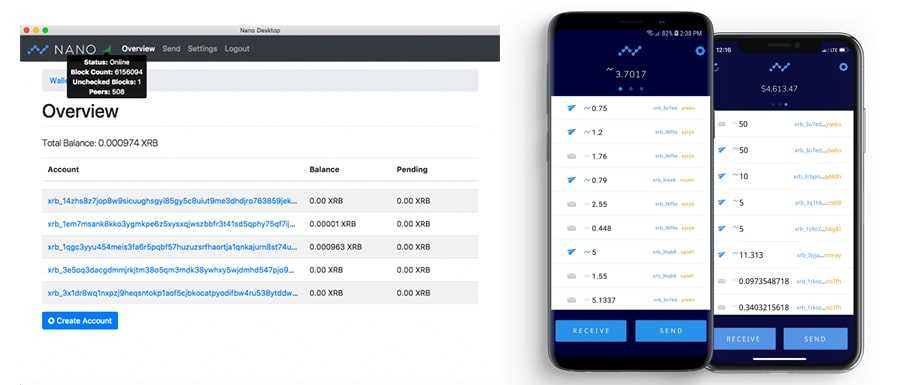
For those of you who are on the go, you will be happy to know that the Nano Wallet Company has also developed a mobile wallet that is available on both iOS and Android. They also maintain and update the codebase. Both versions are secure and simple to use, having been built primarily with the user in mind.
Open Source ⌨️: The Nano Wallet is open source which means that you can view the source code in their GitHub. This is often viewed as more secure than closed source as external developers can also vet the code.
The mobile wallets are free to download and use, and feature instantaneous NANO transactions with zero fees over a decentralized network. Both versions also make it easy to backup and save your wallet seed, share your wallet address with others via QR codes.
You can also send a Nano Share Card to others through the wallet Share Action, or via Messenger. Just remember that mobile wallets are the least secure storage due to the ease of hacking mobile devices.
Canoe Wallet (Desktop & Mobile)
The next wallet on the list is the Canoe wallet. This is another officially recommended wallet by the Nano foundation and is supported on both desktop and mobile devices.
Canoe is an open-source and cross-platform NANO wallet giving you transparency and total control over your NANO in a secure manner.
Canoe gives you the fee-less and instant transfers you expect when using NANO. Perhaps best of all is that you can download and use Canoe on your desktop computer or on both Android or iOS mobile devices.
I decided to take a look into the iTunes store and Google Play Store to see what the community was saying about the wallet. As you can see below, it gets top marks from many of these users (some of the best ratings that we have seen)

The only downside to Canoe currently is that it isn’t recommended to use the same wallet on both the desktop and mobile versions, but that is expected to be fixed soon.
Natrium Wallet (Mobile)
The next wallet to be recommended by the Nano foundation is the Natrium wallet. This is a mobile wallet that was developed by Appdito. It is available in both iOS and Android.
Like many of the other mobile wallets on this list, it is pretty quick and easy to set up. You can also secure the wallet not only with a pin but also with your biometric information.
There is a "contacts" section where you can store address details of those who you regularly pay. If you want to receive payments from someone then you can also share your personal QR code.
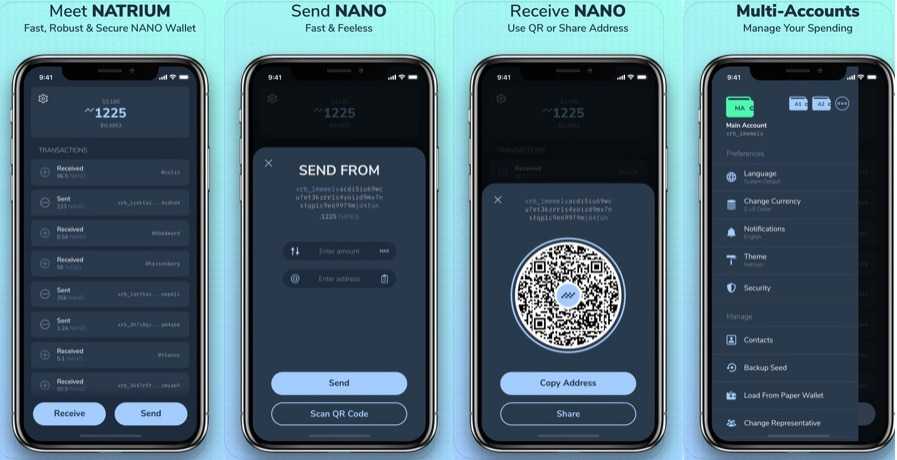
I also think that the user interface of the Natrium wallet looks much more clean and intuitive. Like the Nano Wallet Company mobile wallet, you can add a number of Nano addresses.
Personalisation 📱: Something else that is pretty neat is that you can change the wallet them with the Natrium. This could personalise your user experience.
Finally, like the Nano Wallet, the code is open source and can be viewed on their GitHub. The developers have also encouraged external developers to fork the code and work on the wallet themselves.
Exodus Wallet (Desktop & Mobile)
The Exodus wallet is not listed by Nano as one of their preferred wallets although it is one of the most well known third party wallets on the market.
Exodus is free to download and is a multicurrency wallet which has support for over 100 coins. It has support on Windows, Mac, iOS and Android devices.
One of the best features about the Exodus wallet is its user friendly interface. You can easily switch between your various crypotocurrencies as well as track your combined portfolio.
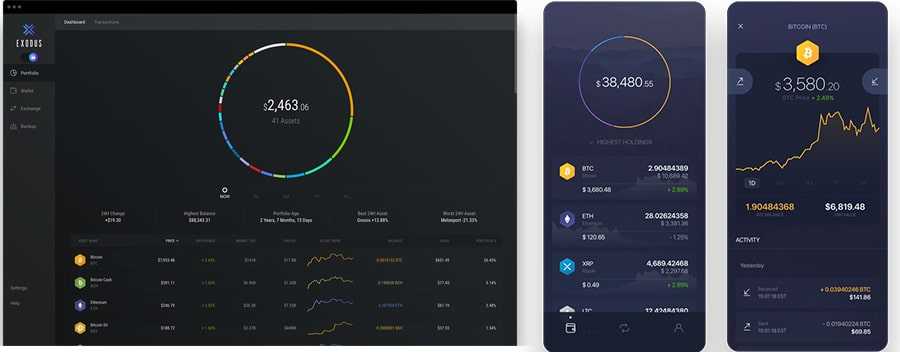
Another really neat feature of the Exodus wallet is the in-built support for exchanging various cryptocurrencies. Hence, unlike other wallets you won't have to first send your crypto out - you can swap it right there on the wallet.
Open Source ❓: Exodus is not fully open source. However there are many open source components that you can view in their GitHub repos.
Something else you may appreciate is the level of customer support at Exodus. Not only are they quick to respond to queries placed in online tickets but they are also on top of their reviews in the Google Play / iTunes stores.
In these respective stores, nearly every comment (positive or negative) is attended to by the exodus team. In general though, most of the comments and ratings appear to be quite positive.
Guarda Wallet
Another third-party wallet that you may want to consider is that of Guarda wallet. This was developed by a company that is based in Estonia and actually holds a financial services licence in that country.
Not only does Guarda support NANO but it also has support for up to 10,000 other tokens and coins on different chains. It is available on Desktop and mobile and it is supported on a number of different devices.
Something that you should know is that you are always in control of your private keys. However, these private keys will have to be kept on your PC or mobile device. However, if you would like to upgrade your security then you can do that too as this supports the Ledger devices that we mentioned above.
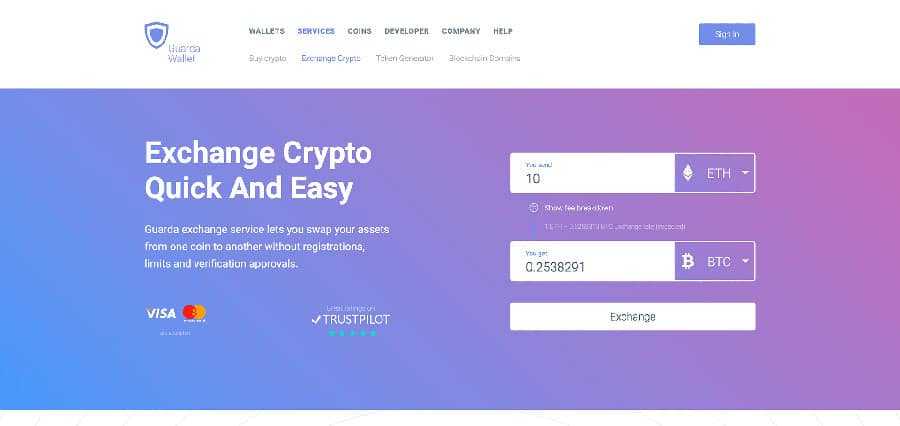
If you have your NANO on the device and would like to exchange it for one of the hundreds of supported coins then that is also pretty simple. All you need to do is use the in-built exchange function. This may include a fee but it does bring a hell of a lot of convenience.
The Guarda device appears to have pretty strong support among the Nano community and people have had positive experiences with it. You can check these out yourself by jumping into the app store ratings and reviews.
Something else that you may appreciate about the Guarda wallet is the support that is offered by the team. They appear to be quite quick to respond to technical queries and there is also a pretty sizable Telegram community who can also help you out.
One more neat feature that you may want to avail yourself to is the fact the Guarda wallet supports multisig. This means that if you would like to set up a wallet with a number of other users then you can. You will require more than one key in order to sign a transaction.
NanoVault (Web Wallet)
The NANO Online Wallet, also known as the NanoVault, gives you access to and control over your NANO assets without having to download the entire blockchain as you would with a desktop wallet.
This is also the wallet that we mentioned earlier when you are using your Ledger Nano Wallet. This gives you the security of a hardware wallet with the ease of use of the web wallet.
Of course, you can also use the NanoVault on it's own without the Ledger. All you need to create an online wallet is your email and a password. Once you have supplied this they will give you your wallet identifier and a Seed.
Having the wallet online is convenient since it allows you to access it from any internet-connected device with a browser, but it also means you need to take some responsibility for security on your own shoulders.
Beware ☠️: Web wallets are risky because they are easy targets for hackers. Phishing is common on web wallets so always be sure that you are on the official Nano Vault domain: nanovault.io
Then, you are ready to go and start using the wallet. Given that web wallets are not as secure as other options, I would advise you to only use this type of wallet for small transactions and not for sizable coin storage.
NANO Paper Wallet
A paper wallet is a super-safe and secure way to store your NANO, provided you can assure that the paper wallet itself doesn’t get destroyed.
That’s simple enough to do by creating several copies and storing them in several locations. There are even several styles to choose from so you can print a wallet that suits you.
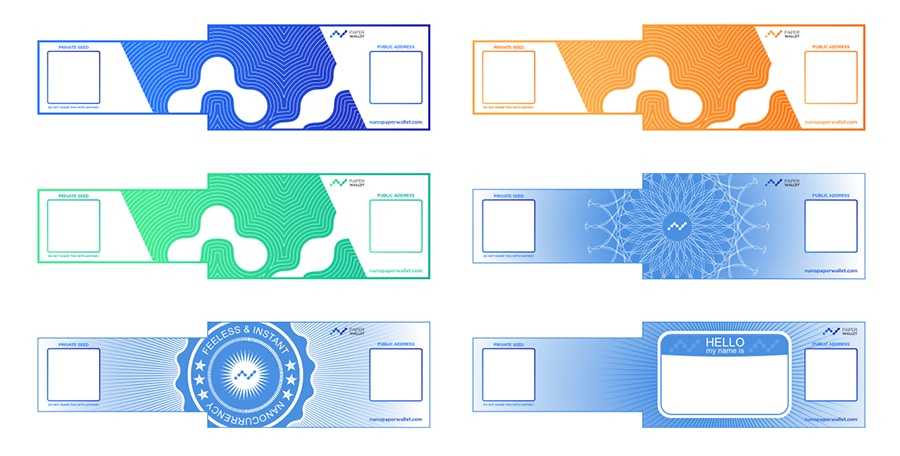
To be completely safe it is recommended to use a computer with a fresh install of Linux, along with a dumb printer and to generate the wallet with your computer offline.
Once you have your paper wallet, you can keep it in cold storage, i.e., disconnected from the internet. Depending on the amount that is being stored on the device and how much it means to you, you may want to consider something like a bank vault or safe.
Conclusion
And there you have it, the top 7 best Nano wallets currently on the market.
If you are looking for the most secure option, then you can't really beat that of a hardware wallet. If you would prefer to have another cold storage option then you can consider a paper wallet.
However, the Nano Wallet for Desktop / mobile is also a good option provided that you keep your computer or phone free of any malicious programs or apps.
Following that, all of the other wallets will do the trick. The Exodus is great for multicurrency support but the lack of full open source code could be a bit of a challenge for those extremely concerned about security.
Irrespective of which wallet you do choose to use, be sure to employ the best practices when it comes to wallet security. Always back up your Seed words and be careful of what you install and who you tell about your NANO Stash!
Places to Buy NANO
Disclaimer: These are the writer’s opinions and should not be considered investment advice. Readers should do their own research.
